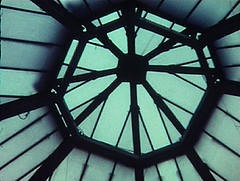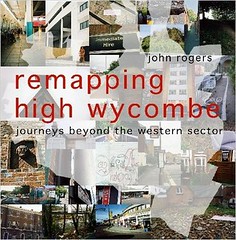Wycombe Drift #1
We rendezvous at the Wycombe District Council Planning Office. The staff are friendly and helpful and hand over the latest plans for the scheme which apparently is now called The Wycombe Regeneration Project.
Looking at the drawings and plans induces a raging hunger and although the traffic flow diagrams are mildly hypnotic we need food. We head off for Frank’s Caff on Frogmoor only to discover that it’s gone, replaced by some Formica-free takeaway place. We end up in Littlewoods café and leave a calling card on one of the menus.
We start our orbital tour of the site at the side entrance to the bus station on Lily’s Walk which is like a portal into the fume-soaked sunless Hades that is Wycombe Bus Station. I admire the geometric patterns formed by the cris-crossing concrete ramps of the multi-storey carpark. The alley that runs off to the left leads to the old Wanderers pitch of Loakes Park and I have memories of the excitement of being in the pre-match throng as a kid and the fear of being caught up in the ruck after the Slough Town Cup match. Cathy takes photos of the dilapidated gas works in all its rusted elegance. Men in fluro vests pass carrying plans and white spray paint. Traffic. Two women in saris.
I climb the bank next to what is/was the Dole office, step over the wooden fence, stand outside the zone, feel it from the raised level shaded by trees. This spot feels special somehow – a remnant of the old path through to the Rye? It’s wedged in between roads and brick walls. Looking at old maps in the pub later this could be what’s left of Pagan’s Mead.
Post office vans lined up in the car park. "He’s been so pissed off. He got laid off in December…" two dolled-up girls pass by. The Desborough Road section is desperate. Take-aways, boarded up derelict shacks. Fried Food Strip. Best One Foods. Tuckin Takeaway with Pukka Pies. AT&T Video, Pizza and Kebabs. Numerous alleys ripe for night-time vice lead into the carpark – neglected corners of coke cans. Loud Hindi music blaring from suped-up Nissans, close-cropped youths, bleach blonde black-rooted girls, drawn faced guy on crutches, black youths in hooded tops, white boys in Hackett rip-offs.
Cultures meet/collide on the corner of Bridge Street and Desborough Road. Caribbean, Asian, White, mixed race. Hooded top, Sari, Hackett. Second Hand City on the opposite corner looks as though it’ll survive – furnish the new units? The old map shows that the boundary of the Borough cut through here and it has retained that borderland feel.
Dougie’s Snacks Take Away on Bridge Street "Feeding Wycombe since 1989. Food that’s good enough to eat!" Bridge Street gives me nothing leaves me cold except a planning notice and a view of the site from the corner of Denmark Street – the Church spire pokes up above the Octagon. All the interest is on the other side of the road - Le Sandwich boasting Segafredo coffee and the College Halls student colony. The Esso petrol station is boarded up, decommissioned, environmental hazard.
Oxford Road. The Leaning Tower of Pizza has risen nearby Scorpion Records - the gravitational centre of my Wycombe. I can’t resist going over. I chat with Cheryl and Steg and tell them about our project. Steg has been in the shop for 29 years and says there have always been plans for the site. He makes some good suggestions for creating 3D walk through maps with transparent screens. Maybe we’ll stick one in the carpark.
Oxford Road is a racetrack, grass it over, restore it to meadowland, that’d be the civilised thing to do. Forget about bowling alleys, this is Death Race 2000. The pigeons love the carpark. Police sign warning you not to leave valuables in your car. The roundabout looks like a burial mound – the final resting place of crushed up Cortinas.
I rendezvous with Cathy outside Tescos (a poster behind the checkout reads: "Helping you to spend less everyday". This could be a slogan for the anti-consumerist brigade). We survey the site from the top of the multi-storey carpark. The town pours into the parking bays below, from the roads propelled by the roundabout, from the lanes running down from the higher ground, it all runs off into this spot, just like the Wye stream.



